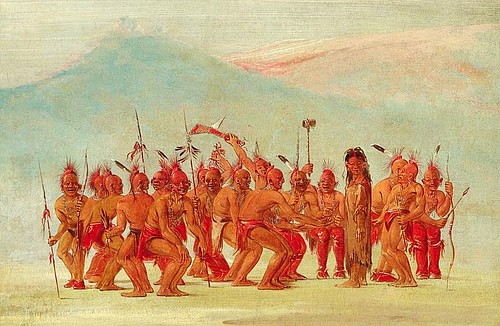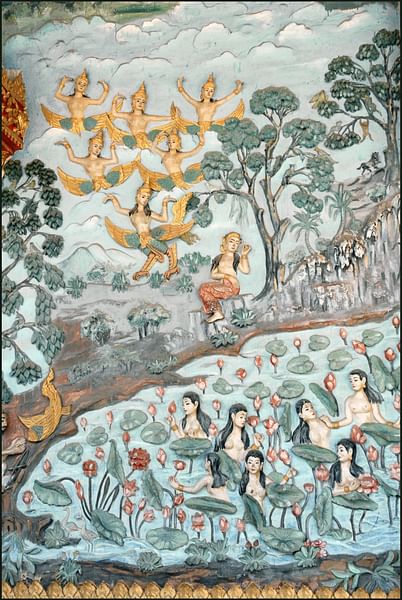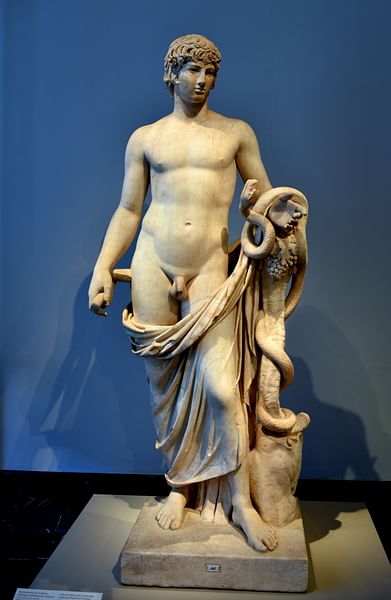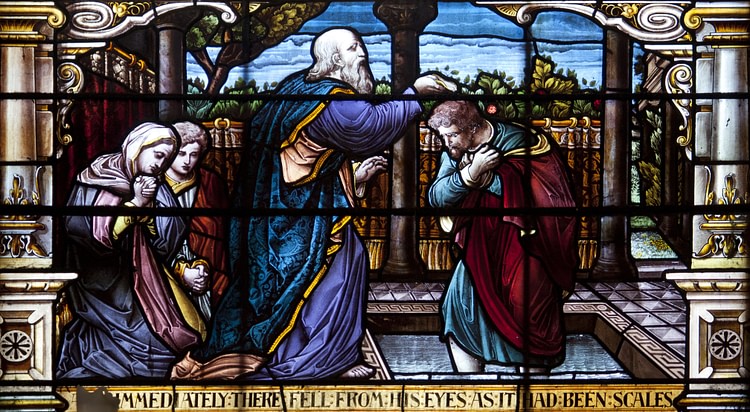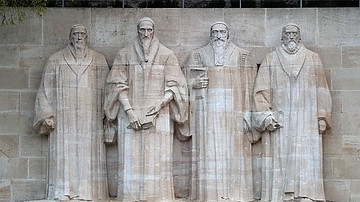Issues in the modern-day regarding gender identity and civil rights for members of the LGBTQ community are a relatively recent phenomenon as are the terms 'homosexual' and 'heterosexual'. In ancient societies, there was no distinction made between same-sex and opposite-sex couples as both were equally acceptable.
The terms 'homosexual' and 'heterosexual' are modern constructs of the 19th century, coined by the Austrian writer Karl-Maria Kertbeny (l. 1824-1882) in an 1869 pamphlet arguing against the Prussian sodomy law that criminalized same-sex relationships. Kertbeny, a closeted gay man, had lost a close friend in his youth who killed himself after he was extorted by a blackmailer who found out he was gay. Kertbeny’s later works tried to remove the stigma attached to same-sex relationships which were regularly defined as perversions.

The pamphlet was published anonymously, but the terminology was used by the naturalist Gustav Jager in his work Discovery of the Soul in 1880 and then by the psychiatrist Richard von Krafft-Ebing in his 1886 Psychopathia Sexualis, translated into English in 1890. The terms were then popularized by the physician and writer H. Havelock Ellis (l. 1859-1939). Although homosexual relationships were, of course, recognized prior to Kertbeny, he was among the first to argue that one’s sexual preference and gender identity was innate – not a choice – and that a gay man should not be equated with effeminacy by pointing to great heroes of antiquity who were gay.
History, both modern and ancient, tells the stories of many people whose sexuality is downplayed or ignored because, for centuries after the rise of Christianity, homosexuality was considered a shameful sin. No discussion of Plato or Alexander the Great or any other notable figure from the past dwelt long, or at all, on their sexuality until the 19th and 20th centuries. This paradigm has now changed for the better and allows for a deeper and broader understanding of the past and the LGBTQ community’s contributions to history.
The following list is only a small sample of the many having to do with the community presently identified as LGBTQ. Although differently gendered people seem to have always been identified as such, in some civilizations this meant they had been elevated by the divine while, in others, the distinction did not seem to matter or, in the case of the Greeks and, in some periods, Romans, same-sex male relationships were considered superior. Examples below are from multiple cultures spanning thousands of years but all sharing the commonality of what, today, would be understood as acceptance and embrace of members of the LGBTQ community.
Transgender Clergy of the Cult of Inanna
Inanna was a popular Mesopotamian goddess who would later become famous as Ishtar and whose clergy were bisexual and transgender. Scholar Colin Spencer notes: "There were lesser priestesses who were also musicians, singers, and dancers, certainly some of these were men who also copulated with both men and women" (29). Male transgenders, who had castrated themselves, were known as kurgarra; females who identified as males were called galatur. Inanna/Ishtar, goddess of love, sex, war, and fertility, was thought to have transformed these people through her divine power and they were regarded as her sacred servants. In the famous poem, The Descent of Inanna, the kurgarra and galatur are said to have been created by the Father God Enki who makes them “neither male nor female” and gives them the food and water of life to free Inanna from the underworld. The transgender clergy were not universally accepted, there is evidence some people personally disapproved of them, but they were still regarded as mediators between the world of humans and that of the divine and, although their behavior was sometimes criticized, they were still respected.
Native American Tribes & the Two-Spirit
The Native American peoples of North, Central, and South America also respected those whom the gods had touched and transformed. They recognized a third gender, known in the present day as a Two-Spirit, both male and female (though this is a modern term, the original having been lost). A Two-Spirit (referenced in 17th- and 18th-century European works as a Berdache) was a man or woman who identified as the opposite sex; men dressed and took on the tasks of women, and women, less often noted, wore men’s clothes and performed the jobs associated with masculinity and male power.
The Two-Spirit was not only completely accepted by the community but valued. A boy who was on the threshold of manhood would receive a message from the Divine regarding who he truly was and what path he must follow and, afterwards, would begin to dress as a woman and focus on sewing, gathering wood, building shelters, and cooking instead of hunting and warfare. The Native American acceptance of differently gendered people and same-sex relationships is noted by a number of European missionaries and explorers who repeatedly condemn the natives as immoral, shameful, and perverse, but these practices and beliefs had existed for thousands of years, presumably, long before the missionaries and their judgment arrived.
The Duke & His Courtier in ancient China
One of the many tales from China celebrating same-sex relationships, and certainly the best known, is the account of Duke Ling of the State of Wei (r. 534-493 BCE) and his lover Mizi Xia, a courtier of great beauty. When Mizi Xia heard that his mother was sick, he borrowed Duke Ling’s carriage to go see her without asking permission, an act which normally would have resulted in severe punishment, but the duke instead praised his lover for his filial piety. Another time, while the two were walking, Mizi Xia was eating an exceptional peach and offered half to the duke who exclaimed, "How great is your love for me. You forget your own appetite and think only of giving me good things to eat!"
Duke Ling was married and had a son, but it was understood a man could also have a romantic relationship with another man without upsetting the marriage. The phrase translated as "the love of the half-eaten peach", "love of shared peach" and "the bitten peach" came to be used for romantic same-sex relationships from the time the story was first told by the Legalist philosopher Han Feizi (l. c. 280-233 BCE) of the Qin Dynasty until Western Christian attitudes toward homosexuality began to influence Chinese culture. The story of the two lovers continues after Duke Ling has fallen out of love with Mizi Xia and then complains how his former lover once used his carriage without permission and gave him a half-eaten peach.
The Elite Force of Gay Lovers in Greece
The Sacred Band of Thebes was a select group of the greatest warriors of the Theban army. It was comprised of 300 men, 150 couples, who were highly respected for their military record as they were consistently victorious in battle for over 30 years. The couples all fit the accepted Grecian pattern of same-sex male romantic relationships of an older man (the erastes, “lover”) and a younger (the eromenos, “beloved”). The Sacred Band was so-called because of vows taken by the couples at the shrine of Iolaus, one of the lovers of the hero Heracles, dedicating them to each other in the name of the god of love, Eros. The group was formed in the belief that each man would prefer to fight and die bravely than allow himself to be seen as a coward by his beloved. The Sacred Band of Thebes were undefeated from the Battle of Leuctra in 371 BCE until they were annihilated by the Macedonians at the Battle of Chaeronea in 338 BCE.
The Gay King of Egypt Pepi II
Same-sex relationships do not receive a great deal of attention in the works of ancient Egypt, possibly because they were not considered anything worth remarking on. As in China or Greece, what two consenting adults wanted to do in a romantic relationship, whether same-sex or opposite-sex, was their business only. One story, however, is told of the King Pepi II Neferkare (r. c. 2284 BCE) of the Sixth Dynasty of the Old Kingdom of Egypt (c. 2613-2181 BCE) who appears to have had a relationship with his general Sasenet.
In this story, Pepi II leaves his palace for four hours at night, goes to Sasenet’s house, and does “to him what his majesty desired”, a euphemism for sex. Pepi II’s actions are open to interpretation, however, and some scholars claim he was enacting a ritual in which he played the part of the god Ra who visited Osiris, Judge of the Dead, in the underworld for four hours at night. This interpretation fails to address the judgmental tone of the Middle Kingdom scribe who wrote the original text. It seems he does not approve of Pepi II sneaking out of the palace at night though whether he disapproved of the actual relationship is unclear.
The Third Gender of the Kinnar
Same-sex relationships and the existence of a third gender are mentioned in the ancient Hindu texts of India. The Manusmriti, a law code from c. 1250 BCE, recommends ritual purification after same-sex relations, but this same applies to opposite-sex unions. The Kama Sutra (c. 400 BCE) encourages same-sex unions and discusses the third gender (“third nature”) casually. The Kinnar (also known as Hijra) are a recognized third gender on the Indian subcontinent in the present day and are alluded to in texts like these going back over 2,000 years. They refer to themselves as Kinnar after the celestial musical creatures of Hinduism who were part bird, part horse, and part human, while Buddhism uses the same term to refer to the Divine Musician who is half human and half bird.
Those who identify as Kinnar are born male but live as female, and many are associated with the Shakti movement, recognizing the primacy of the creative cosmic force which many Kinnar associate with the goddess of transformation, Bahuchara Mata, an earth and fertility goddess who embodies the creative and destructive nature of Shakti. She is sometimes referenced as the goddess of transgenders. The Aravani of southern India are another sect of the third gender who focus worship on the god Arvan instead of the goddess.
Honor & Gay Relationships in Japan
In Japan during the Pre-Meiji Period (800-1868 CE), same-sex relations among men were considered "an honored way of life among the country’s religious and military leaders so that its acceptance paralleled, and in some respects even surpassed, ancient Athens" (Crompton, 412). As in Greece, male same-sex relationships were thought to improve the character and spirit of both participants while sexual relations with a woman, overall, were valued only as a means of procreation and preserving the family name. This social paradigm was respected until it was first challenged by the arrival of Christian missionaries from the West beginning with Francis Xavier (better known as Saint Francis Xavier, l. 1506-1552 CE) who denounced homosexual love as a sin.
The Japanese understood such relationships simply as nanshoku ("love of males" or "male colors") without any connotation of wrongdoing attached. During the Meiji Period (1868-1912 CE), Western values increasingly gained ground in Japan and same-sex relationships came to be regarded as sinful and then criminal. Many of the most famous and honorable samurai engaged in same-sex relationships as did monks, political leaders, and others who, after the spread of Christianity, had to either hide who they were or face persecution.
Roman Ideal of Masculinity & Same-Sex Relationships
The Romans, like the Greeks and others, regularly pursued same-sex relationships. Criticism of these had nothing to do with the relationship itself but focused on one’s passivity in sexual intercourse. To 'play the part of a woman', if one was male, was considered dishonorable in that one had given away one’s virility and was no longer a 'true man'. At the same time, there are many reports of great figures, such as Julius Caesar (100-44 BCE), who were said to have played the passive role in sex and remained well-respected. Spencer notes: "Caesar’s character fulfilled Roman expectations. He was physically strong, he had great military skill, forbearance and tenacity and he was highly sexual…A man who had such a reputation could be allowed to slip occasionally, into the passive role and still be a man" (74). A same-sex committed relationship, modeled on the Greek in which a lover improved the character of the beloved, was respected, as exemplified in that of the Roman emperor Hadrian (r. 117-138 CE) and his lover Antinous (l. c. 110-130 CE) who was deified after his death and whose cult was a major rival of the new religion of Christianity.
Celtic Warriors & Their Male Lovers
The Celts are regularly described by Roman writers as formidable warriors, but the historian Diodorus Siculus (l. 1st century BCE) adds that they also preferred same-sex relationships. While the Romans disapproved of men taking the passive role in sex, Diodorus notes that the Celts did not see this as a problem:
The men are much keener on their own sex; they lie around on animal skins and enjoy themselves, with a lover on each side. The extraordinary thing is they haven’t the smallest regard for their personal dignity [and] offer themselves to other men without the least compunction. Furthermore, this is not looked down upon or regarded as in any way disgraceful. (Spencer, 94)
Diodorus was not criticizing the nature of the relationships but the passivity of one of the partners, which was at odds with Roman cultural norms. As with other examples above, the Celts continued to regard same-sex relationships as normal and natural until the rise of Christianity.
Bible Condemns Idolatrous Behavior, Not Homosexuality
Christianity had this effect on so many cultures because of the interpretation, not the translation, of the Greek word arsenokoites, which, according to theologian Justin R. Cannon, literally means "male beds" and seems to have been coined by Saint Paul the Apostle in reference to men who slept with men in pagan cultures (9). This word was interpreted by European translators as "sodomites" or "sexual perverts", but it originally seems to have been intended to reference what Paul saw as a regular practice of non-Christians. One of the biblical passages most often cited in the present to condemn same-sex relationships, Romans 1:24-27, in any translation, mentions how men and women gave up "natural relations for unnatural" and committed "shameless acts" but, in the context of the whole passage, this should be understood as referencing idolatrous behavior – behaving as pagans did at orgies – rather than a committed gay relationship.
Another line frequently cited, Leviticus 18:22 – "Thou shalt not lie with a man as with a woman; it is an abomination" – is also not referencing that kind of relationship but is only expressing the same distaste as the Romans had for a man taking the passive role in sex. Later European translators of the Bible interpreted the reference to pagan sexual practices as deviance, and this was finally interpreted as 'homosexuality' in the 1946 Revised Standard Version of the Bible (Cannon, 9). The word does not appear in the Bible prior to that date.
Conclusion
The verses in the Bible now used to condemn same-sex relationships, read in context, are actually condemning sexual licentiousness associated with earlier belief systems and even those contemporaneous with early Christianity. Paul’s letters urge his audience to distance themselves from a number of different practices and traditions of their cultures and adopt new ones in keeping with his vision of Jesus Christ’s mission, he is not singling out same-sex relationships as a sin. Some scholars, in fact – including the bishop John Shelby Spong - have suggested that Paul’s "thorn in the flesh" (II Corinthians 12:6-7) is a reference to his own homosexuality which he seems to have struggled with.
It has also been pointed out that the story of Sodom and Gomorrah from the Book of Genesis, also frequently used to condemn homosexuality, is actually a cautionary tale on the importance of hospitality. The early Christian scholar Origen (l. c. 184 - c. 253 CE) interpreted the story along these lines as did Church Fathers such as St. Ambrose (d. 397 CE). The sin of the people of Sodom and Gomorrah, according to these writers, was their failure to abide by the established rules of hospitality and had nothing to do with their sexual orientation.
Although there is certainly evidence of negative personal views toward homosexual practices in pre-Christian civilization, these seem to have to do with either loss of a man’s virility and status as a man, loss of a young woman’s virginity, or, in the case of certain periods of Roman history, extreme licentiousness and promiscuity. These criticisms focused on people’s behavior, however, not on same-sex relationships per se. How one chose to conduct one’s private, romantic relationships was one’s own business which was freely pursued and recognized by others as simply another expression of human sexuality.
